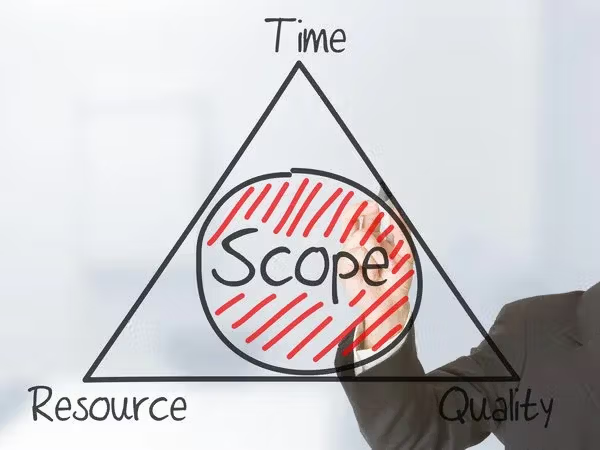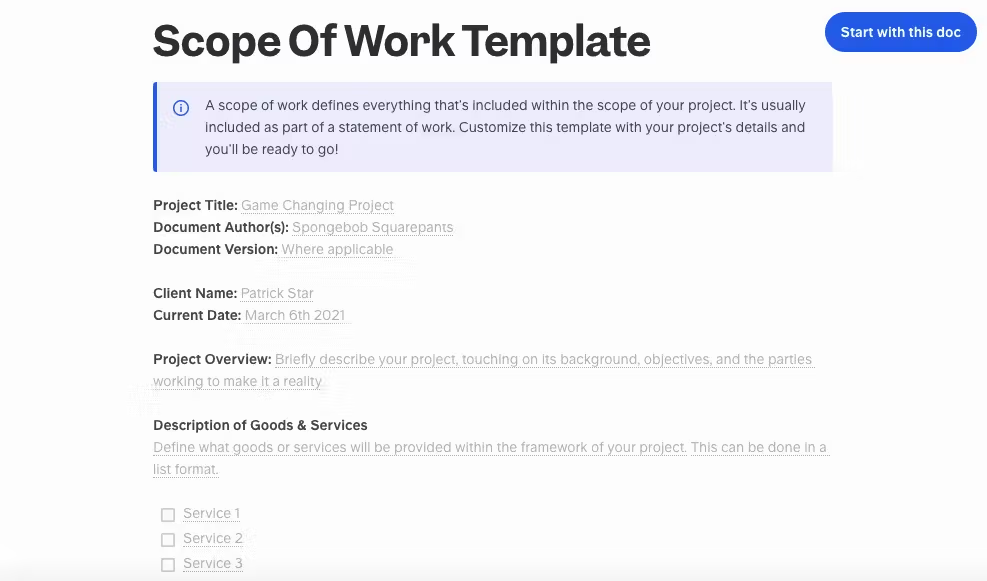What is a scope of work?
A scope of work is a key project management document that describes what falls under the framework of a project, and what doesn't. Scope of work documents ensure that all parties agree on what tasks will be carried out and delivered in a project's lifecycle. They align criteria, expectations, and terms clearly and concisely.
Why is a scope of work important?

Scope of work documents are indispensable project management tools for a wide range of reasons. The following are some of the most potent examples.
Having a written record of important information
Even the most straightforward project can get complicated once it's been worked on for a month of two. Scope of work documents are beneficial because they provide written records of all your project's most important information.
Instead of getting bogged down with miscommunications and misunderstandings, you'll be able to use your scope of work as a resource whenever you need to make what you agreed upon at the outset crystal clear.
Keeping project team members on track
When you know exactly what tasks and deliverables make up your project, it's a lot easier to get things done and delegate work to project teams. Scope of work documents help achieve this because they force project teams to get all their project's most important details on paper early on. You'll know exactly what needs to happen to ultimately complete the project and work backwards from there.
Scope creep avoidance

Ah, the dreaded scope creep. The term alone strikes fear into the hearts of project managers and project teams alike. If you're lucky enough to be unfamiliar with scope creep, it's what happens when work on a project slowly and steadily increases beyond what was initially agreed upon. It results in going over budget, insufficient compensation, conflict, frustration, delays, and other nasty things.
Scope of work documents help avoid this because they put exactly what's contained within the framework of a project into writing. If you sense the onset of scope creep, you can face it head on by referring back to your SoW document.
Increased communication
At the end of the day, scope of work documents start conversations. We're not only referring to internal dialogue, but also communication between project managers and clients and/or stakeholders.
The best scope of work documents are written collaboratively, so most project managers meet with their clients to discuss project goals, expectations, and requirements before writing anything down. Meetings like this start relationships off on the right foot, foster transparency, and make sure that everyone is on the same page.
Staying within your budget
When a project goes way over budget, no one's happy. So, it'll be music to your ears that scopes of work are great tools to ensure that your project stays within its budget.
Writing a scope of work involves identifying all the tasks, events, milestones, and deliverables that make up a project. Once you've identified those in detail, it will be a lot easier to develop an accurate budget that covers all your project's bases.
What should a scope of work include?

Your scope of work document's contents will depend on the specific needs of yourself, your client, and your project. However, the following sections are usually included.
If you want more specific guidance, we've got a free scope of work template for you to use.
Key project information
Be sure to include all your project's basic details that will help the reader identify it at a glance. This normally consists of project name, document author(s), document version, client name, and current date.
Project overview
Provide a brief description of your project. Include information related to project background, project goals, your problem statement, and the people who'll be working on it, but keep it concise.
Description of goods & services
Now we're getting to the meat of the project. Describe the goods and/or services that will be performed or delivered within the framework of your project. This is often done in list format.
List of tasks

It's time to break your project down into smaller chunks. Identify all the tasks and subtasks that will need to be carried out in order to ultimately complete it. It's handy to present this as a table and include details on projected dates and contact people.
Project deliverables
Specify exactly what your client will be receiving by the end of your project. This defines what success looks like for your finished project and establishes clear expectations for your client. It's particularly important to be specific and clear here.
Period of performance
Specify the overall time frame of your project. Determine when it will begin, when it will end, and what achievements and milestones will be accomplished along the way.
An out-of-scope list

This section isn't always included but it can really help take your SoW to the next level. If there's anything you want to make absolutely clear is not accounted for within the bounds of your project, it's a great idea to list it here.
Protocol for changes
Scope of work documents are written at the very beginning of a project's lifecycle. Owing to this, you'll often have to make a couple changes to them before your project concludes. In order to account for this eventuality, it's advisable to agree upon a protocol for doing so. That way both you and your client will understand exactly what needs to happen to make any changes to the SoW.
Payment terms
At the end of the day, everyone needs to get paid. Avoid problems down the road by nailing down payment terms, schedules, conditions, and details in your SoW document.
The difference between a scope of work and a statement of work

Statements of work and scopes of work are very closely related documents, so they're often confused. Additionally, they're both confusingly abbreviated as SoW. Not to worry, we'll clear up the difference for you and you'll never forget it!
A scope of work document is usually a section or a page within a statement of work. A statement of work is a much longer and more detailed project management document that outlines all the most important elements of a project. It's a formal document that's essential to the project planning process and sometimes even acts as aacts a work agreement or initial contract between service provider and client.
A scope of work is a shorter, more concise document that focuses on exactly what elements make up a given project. It plays an important supporting role to the statement of work and is often one of the most difficult sections to finalize.
Who should provide the scope of work?

A project's scope of work should be developed by the project manager and the client. One of them is usually providing a product or service, whereas the other is contracting a product or service.
As mentioned, writing a great scope of work is a collaborative task and often involves consultation with other parties like project teams, contractors, and other stakeholders. Nevertheless, the project manager and the client will have the final sign off on the finalized document.
Work on a project doesn't begin until both parties agree on the contents of the scope of work document. As such, this is a key document and key moment in the beginning of any project's lifecycle.
How to write a scope of work
Step 1: Meet with your client
First things first, meet with your potential client and discuss your potential project. This meeting is essential and will lay the groundwork for a successful scope of work document. Be sure to take note on their thoughts on project deliverables, timeline, budget, and scope. Also consider whether you discover any red flags or things you don't see eye-to-eye on.
Step 2: Meet with your project team
Now that you've met with your client, you probably have an initial idea of how your project scope will look. Before getting started on your draft, meet with key members of your project team. Have a brainstorming session and discuss the different elements of your project and potential scope of your work. Get everyone on board and make sure that the initial project requirements are realistic, reasonable, and doable.
Step 3: Make a draft
Now, you're ready to write the first draft of your SoW. You may be working off a scope of work template, a past scope of work example, or starting completely from scratch. Whatever the case, be sure to keep your client's and team's feedback in mind.
Step: 4: Review, review, review
Once you've finished your draft, don't deliver it right away! It can be tempting to do so, but it's a better idea to put it aside and give it another read through a day or two later. It's also advisable to get a few more pairs of eyes on it to give it a proofread, provide feedback, and determine whether everything is consistent.
Step 5: Deliver your SoW to your client
Once you're happy with your scope of work document, you'll have to pull the plug and deliver it to your client. You won't be able to start work on your project before they sign off on your SoW, so hang tight and wait for their feedback.
Step 6: Communicate with your client & make any necessary changes
When your client gets back to you, they will most likely have feedback. Meet with them and discuss their comments, questions, and concerns. You may have to edit or fine tune your SoW at this stage, or even negotiate specific elements, but not to worry. You'll reach an agreement and everything will get done.
Step 7: Collect final sign offs
Once you and your client are both happy with your scope of work document, it's time to celebrate! Collect the final sign offs, pat yourself on the back for a job well done, and get excited for your project's official initiation!
A scope of work (SoW) template just for you

Slite's free scope of work template
Project Title: Game Changing Project
Document Author(s): Spiderman, M.J. Watson
Document Version: Where applicable
Client Name: The Green Goblin
Current Date: May 10th, 2021
Project Overview: Briefly describe your project, touching on its background, objectives, and the parties working to make it a reality.
Description of Goods & Services
Define what goods or services will be provided within the framework of your project. This can be done in a list format.
- Service 1
- Service 2
- Service 3
Task List
Break your project down into a series of tasks and subtasks and include them in a list format for optimal readability.
- Task 1
- Task 2
- Task 3
Deliverables: Describe exactly what your client will receive by the end of your project. Make sure to be specific in this section, as it will make sure that all parties involved are on the same page.
Period of Performance: Outline the timeframe of your project from beginning to end. Be sure to account for due dates and milestones.
Out of Scope List
Since the most important part of your scope of work is defining what's included within the framework of your project, if there's anything you want to clarify definitely isn't included within your project scope, list it here.
- Out of Scope 1
- Out of Scope 2
- Out of Scope 3
Protocol for Changes: If either party needs to make adjustments to the scope of work along the way, you'll need to have a protocol in place outlining how to do so. Account for the necessary steps here.
Payment Schedule & Terms: Define payment terms, conditions, and schedules here. Be sure to include payment information where necessary.
How to share your scope of work

Scope of work documents are only useful if they're actually developed, used, and referred back to by everyone working a project. In order to make that a reality, keep the following best practices in mind.
Work on your SoW together
Even though the project manager and the client will make the final sign offs on any scope of work, it's important to work on the document collaboratively so everyone is in the know and involved. It's easy to do so when using a project management software like Slite.
Working on your scope of work collaboratively is extra beneficial because it allows for a wide range of input and feedback, ensuring that all the information that goes into it is accurate and doable.
Share your SoW far & wide
Once your scope of work is finalized, make sure everyone working on your project knows what it is, how to access it, and to refer back to it regularly. A scope of work document simply won't be effective if it isn't used as an essential reference document by everyone on the project team. Share it far and wide: send out links, compose a team-wide email, reference it during meetings... the works.
Keep the conversation going
An effective scope of work shouldn't be created and then forgotten about. Make sure it remains at the forefront of conversations internally and with clients. If something isn't accurate or working well, be sure to address it and fix it. If your work is getting off-track or taking an unexpected turn, consistently refer back to your SoW.
Tips on writing an effective scope of work
Since your scope of work document is so important, it's only logical that it should be written with care. In order to get the most out of your scope of work, keep the following tips and best practices in mind when you're getting started.
Be specific
Writing a scope of work document is not the time to be vague. Your SoW should outline the work to be done within the framework of your project in as much detail as possible. This is the best way to ensure that everyone working on the project is on the same page and that mutual expectations are clear.
Likewise, it's important to be specific when talking about other key details like project deliverables, project schedule, and budgetary & financial details.
Keep it real(istic)
After determining all the tasks, milestones, and deliverables that will make up your project, you'll need to provide an initial budget and project schedule. When doing so, it's important to be realistic and not make any false promises. It can be tempting to exaggerate or commit to getting things done as quickly as possible, but you'll get a lot more credibility and do a better job if you decide on a realistic timeframe and budget.
It's also a great idea to consult colleagues and other project team members when estimating your schedule and budget to confirm that everything is doable.
Communicate openly
Like all things in the project management world, communication is a key element of putting together a great scope of work.
First, you should meet and communicate openly with all the most important people on your project team before submitting your scope of work. This will ensure that everyone has signed off on its contents and will be able to deliver what they've committed to.
It's also a good idea to meet with your client in the early stages of writing a scope of work and/or statement of work. This gives you the opportunity to get a feel for them and have initial discussions on things like project schedule, project deliverables, project objectives, financials, and resources. This kind of conversation will help you avoid any surprises when you deliver the scope of work and ensure that it'll be accepted quickly.
Use visuals
Sometimes a picture's worth a thousand words. Even though your scope of work should be concise, don't be afraid to include photos, charts, graphics or other media if they explain something better than words.
Slite's software makes it easy to add visual elements like files, images, tables, videos, and links into your scope of work document.
Make it short & sweet
A scope of work is usually a section within a larger document like a statement of work or project plan. Owing to this, keep it as concise as possible. It's difficult to strike the right balance between brief and detailed, but you can achieve this by only including need to know information and nothing extra.
You're ready to write an excellent scope of work
If you've made it through this step-by-step guide, you're ready to start writing your very own scope of work. You've no doubt learned what handy documents they are and the amount of problems they help solve and avoid. No one really likes writing documentation, but we promise that scopes of work are highly useful and worth the initial time investment you have to put into developing them.
You have everything you need to become a scope of work expert, so what are you waiting for?

